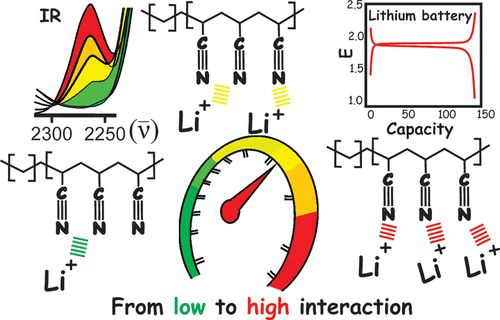当前位置:
X-MOL 学术
›
ACS Appl. Energy Mater.
›
论文详情
Our official English website, www.x-mol.net, welcomes your
feedback! (Note: you will need to create a separate account there.)
Cross-Linked Polyacrylonitrile-Based Elastomer Used as Gel Polymer Electrolyte in Li-Ion Battery
ACS Applied Energy Materials ( IF 5.4 ) Pub Date : 2019-12-27 00:00:00 , DOI: 10.1021/acsaem.9b02129 Nina Verdier 1 , David Lepage 1 , Ramzi Zidani 1 , Arnaud Prébé 2 , David Aymé-Perrot 3 , Christian Pellerin 1 , Mickaël Dollé 1 , Dominic Rochefort 1
ACS Applied Energy Materials ( IF 5.4 ) Pub Date : 2019-12-27 00:00:00 , DOI: 10.1021/acsaem.9b02129 Nina Verdier 1 , David Lepage 1 , Ramzi Zidani 1 , Arnaud Prébé 2 , David Aymé-Perrot 3 , Christian Pellerin 1 , Mickaël Dollé 1 , Dominic Rochefort 1
Affiliation

|
Gel polymer electrolytes (GPEs) based on polyacrylonitrile elastomer (HNBR) are investigated for lithium-ion batteries application. This study examines the acrylonitrile content, as well as the solvent used to make the GPE, to understand their impact on lithium solvation. To do so, we propose a three-component system comprising HNBR:solvent:LiTFSI to pinpoint the correct ratio to provide the GPE with competitive conductivity. Infrared spectroscopy is used to shed light on the interactions between nitriles and lithium ions. Spin–lattice relaxation times (T1) and diffusion coefficients of 7Li and 19F for various HNBR-based GPEs are obtained through PFG-NMR, enabling determination of the transport number of lithium cations (t+) and activation energy (Ea). Among the GPEs tested, those composed of propylene carbonate with 2 M LiTFSI and HNBR with an acrylonitrile content of 50% are the most promising, with an ionic conductivity of 2.1 × 10–3 S/cm, D7Li of 12.0 × 10–8 cm/s, and a t+ of 0.42 at room temperature. When this GPE was tested in Li5Ti4O12/LiFePO4 coin cells, a capacity of 135 mAh/g was obtained at a discharge rate of D/5, showing promising results for its use in Li-ion batteries. This study highlights the benefits of high acrylonitrile content in the polymer and a solvent with a moderate donor number to promote interactions between nitriles and Li+.
中文翻译:

交联聚丙烯腈基弹性体用作锂离子电池的凝胶聚合物电解质
研究了基于聚丙烯腈弹性体(HNBR)的凝胶聚合物电解质(GPE)在锂离子电池中的应用。这项研究检查了丙烯腈含量以及用于制备GPE的溶剂,以了解它们对锂溶剂化的影响。为此,我们提出了一个三组分体系,该体系包含HNBR:solvent:LiTFSI,以查明正确的比例,从而为GPE提供具有竞争力的导电性。红外光谱用于阐明腈和锂离子之间的相互作用。通过PFG-NMR获得了各种基于HNBR的GPE的自旋晶格弛豫时间(T 1)和7 Li和19 F的扩散系数,从而能够确定锂阳离子的传输量(t+)和活化能(E a)。在所测试的GPE中,最有前途的是那些由2M LiTFSI的碳酸亚丙酯和丙烯腈含量为50%的HNBR组成,其离子电导率为2.1×10 –3 S / cm,D 7 Li为12.0×10 – 8 cm / s,室温下的t +为0.42。当在Li 5 Ti 4 O 12 / LiFePO 4硬币电池中测试该GPE时,在D放电速率下获得的容量为135 mAh / g/ 5,显示其在锂离子电池中的使用前景可观。这项研究强调了聚合物中丙烯腈含量高和给体数适中的溶剂促进腈与Li +之间相互作用的好处。
更新日期:2019-12-27
中文翻译:

交联聚丙烯腈基弹性体用作锂离子电池的凝胶聚合物电解质
研究了基于聚丙烯腈弹性体(HNBR)的凝胶聚合物电解质(GPE)在锂离子电池中的应用。这项研究检查了丙烯腈含量以及用于制备GPE的溶剂,以了解它们对锂溶剂化的影响。为此,我们提出了一个三组分体系,该体系包含HNBR:solvent:LiTFSI,以查明正确的比例,从而为GPE提供具有竞争力的导电性。红外光谱用于阐明腈和锂离子之间的相互作用。通过PFG-NMR获得了各种基于HNBR的GPE的自旋晶格弛豫时间(T 1)和7 Li和19 F的扩散系数,从而能够确定锂阳离子的传输量(t+)和活化能(E a)。在所测试的GPE中,最有前途的是那些由2M LiTFSI的碳酸亚丙酯和丙烯腈含量为50%的HNBR组成,其离子电导率为2.1×10 –3 S / cm,D 7 Li为12.0×10 – 8 cm / s,室温下的t +为0.42。当在Li 5 Ti 4 O 12 / LiFePO 4硬币电池中测试该GPE时,在D放电速率下获得的容量为135 mAh / g/ 5,显示其在锂离子电池中的使用前景可观。这项研究强调了聚合物中丙烯腈含量高和给体数适中的溶剂促进腈与Li +之间相互作用的好处。











































 京公网安备 11010802027423号
京公网安备 11010802027423号